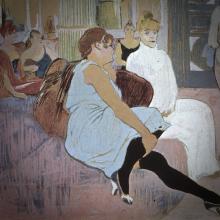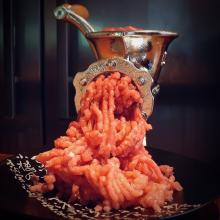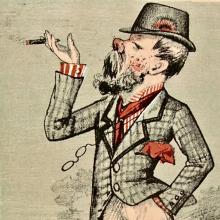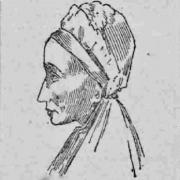
THE STOCKBRIDGE MURDER CASE
1889
Part VI
AN EFFORT TO EXERCISE CALM JUDGEMENT
––––––––––––––
The law has been allowed to “take its course” upon the miserable woman Jessie King or Kean, and yesterday morning, she was executed within the walls of the Calton Prison.
Strong if somewhat spasmodic and tardy efforts were made to get mercy, in the shape of the Crown prerogative, to interpose and arrest the hand of justice. They failed, and no one who gives anything resembling careful and deliberated consideration to the nature of the crime can avoid thinking that the Scottish Secretary has, under circumstances that must have been most painful to him, taken the only course open to him, in accordance with the spirit of the law, in declining to recommend a commutation of sentence.

Strong and stronger shocks of revulsion
It is not easy to exercise a calm judgement on the case of a prisoner whose life is forfeit to the law; and the rarer that executions take place it seems the more difficult to carry them into effect. It is difficult in the case of a man, it is well nigh impossible where the criminal pronounced worthy of death is a woman. The feeling is illogical and unreasonable; for the law should in this matter be no respecter of sex. Nevertheless, it exists in the public mind, and naturally and necessarily influences the decree and the execution of the death penalty.
“Hanging statutes” and “hanging Judges” have long ago been relegated to the dark Ages of our criminal law; and this is well. The public heart has become more tender, and its conscience more susceptible, which is well also, but not without some dangers and disadvantages. It manifests strong and stronger shocks of revulsion at the carrying out of a death sentence, and in time may demand, for its own sake rather than that of the criminals fully and justly convicted of deliberately taking away life, that capital punishment also shall become a thing of the past.
One need not stop to argue whether this would be an improvement upon the present state of the law. It is a matter that in the end will be determined by sentiment rather than by argument or by facts; and as regards the statistical side of the question, evidence is contradictory on the apparently simple issue of whether the countries that have made experiment of abolition found the tendency to what were capital crime increased or diminished. But so long as death is by the law of the land the punishment appointed for such as intentionally and without provocation take away life, a criminal like Jessie King could not properly be a subject for the mercy of the Crown. Hers was not a single act, but a series of acts of murder; and no crimes could have been more deliberate none more unprovoked.
Between the motives and circumstances in her case in those of ordinary child murder there is not merely no analogy; there is antithesis. Instead of being subjected to the strongest imaginable temptation, at a time when body and mind are alike unstrung, her actions were done systematically, in cold blood, and from the basest motives. The fact that she was a woman could scarcely be allowed to turn aside the edge of justice, when her own deeds were the negation of all the most sacred and essential attributes of womanhood. Further, if capital punishment exercises in any case a deterrent influence upon other criminals—which some have doubted—surely this is one where such an effect might be expected. If example is needed, and if example is likely to tell anywhere, it should be among the cowardly miscreants who, it is suspected, make a living in our great cities at the cost of the torture and death of the little children committed to their care.[1]

No excuses for Jessie King
There was no doubt either of King’s guilt or of the enormity of her crimes. The only pleas that could have been looked at as furnishing reason for a reprieve were that she acted under influence or direction of a stronger will, and that her own mind was not capable of forming a conception of the difference between right and wrong. Both pleas were urged, but neither was tenable. Whatever suspicion of connivance may be entertained, King’s acts were her own, and the medical opinion as to her sanity and responsibility for those acts is confirmed, among other things, by her composed behaviour in the last scenes. She was, undoubtedly, of a low moral and intellectual type; but it would be dangerous to grant that it is a privilege of this type to commit murder without incurring its appointed penalty. Repellent and pitiful, as well as happily rare among us, is the circumstance of a woman’s execution, but in this instance it must be pronounced alike just and necessary.
Taking away the vulgar romance
Since an end was put to executions in public,[2] it will be observed that there have been only two occasions upon which the death sentence has been carried out in Edinburgh. The last was the hanging of the two men who brutally murdered a couple of keepers in the neighbourhood of Gorebridge, and the other was the execution of the prisoner Chantrelle. Few can doubt that to make an open spectacle of the last moments of an unfortunate wretch condemned to death was to help powerfully to degrade the public mind and taste, and that it acted rather as an encouragement than a deterrent to capital crime, by allowing the murderer to play the part of a kind of popular hero before being shuffled off the stage. All the vulgar romance of an execution has been taken away, and its grim and terrifying effects have been increased by having this last scene enacted behind the walls.

Press role in proof of death
One feature in the execution of yesterday morning should not be allowed to pass without some inquiry. It will be noticed that the representatives of the press—who in a case of the kind are also the sole representatives of the public—were not allowed to be present when the last sentence of the law was carried out. This is probably within rule and precedent. But it is contrary to what was understood at the time, and supposed since, to be the spirit and desire of Parliament in decreeing that executions should take place in private.[3] It was then urged with some force that there might be cases where the general public, or a section of it, would never be thoroughly convinced that sentence had really been executed if it took place behind barred gates, and in the presence only of those who attended in an official capacity. To remove any ground for suspicion, it was directed that a post-mortem examination should be made, and an inquest held; and it was also believed to be the accepted rule that the eye of the outside public, in the person of the reporters, should be upon the final act. The reasons for this are now as strong as at the time when public executions were abolished; and the reversal of what has been deemed a well-grounded rule should not allowed to pass without examination and protest.[4]
Probably the idea is that impediments should be put in the way of “harrowing the public feelings” by reporting the details of the scene on the scaffold. It is a thing that might discreetly be left to those whose business it is to report, and no great harm would be done. If there is a public desirous of being harrowed, and descriptive writers desirous of harrowing, their mutual wishes are pretty certain of fulfilment whatever officials may do. But chiefly what is to be avoided by those anxious to save the public nerves is secrecy, or, what is much the same thing, the appearance of secrecy; for this is the native element of most that is marvellous, delusive, and blood curdling in popular description and in popular apprehension.
Scotsman, 12 March 1889
[1] Jessie King's crime was twofold: (1) She murdered infants in her care; (2) She murdered them not out of passion or despair or terror, but as a repeated calculation to dispose of one child in order to accept payment for the care of another. There was a horrid suspicion in Edinburgh at the time that such calculations were understood by and silently connived at by a wide section of the population for whom illegitimate children spelt reputational and financial ruin. Perhaps a sense of shared guilt added to the hostility directed at King.
[2] The last woman to be hanged in public in the UK was Frances Kidder, on 2 April 1868; the last man hanged in public was Michael Barrett on 26 May 1868. Capital punishment was abolished in Great Britain in 1965, and in Northern Ireland in 1973.
[3] The Capital Punishment Amendment Act 1868 (31 & 32 Vict. C.24) received Royal assent on 29 May 1868.
[4] In fact the Press were given access to the platform immediately afterwards to view King's dead body hanging from the noose below. The Scotsman's argument appears rather specious.
*****

SEQUEL TO THE JESSIE KING REVELATIONS.
The Lord-Provost’s Committee of Edinburgh Corporation to-day discussed a motion by Mr Robert Anderson, which asked the Council to petition the Government with a view to introducing such a bill into Parliament as would prevent a repetition of such offences as that for which Jessie King suffered the extreme penalty of the law, the revelations made at her trial rendering it absolutely necessary that the lives of young children should be protected by legislation.[5]
The committee instructed the Town Clerk to prepare a memorial to the Government, praying that such a measure should be introduced, or that an amendment of the law with reference to unprotected illegitimate children, should be immediately made.
Edinburgh Evening News, 27 March 1889
[5] The 1889 Prevention of Cruelty to, and Protection of, Children Act rendered liable to punishment ‘any person over 16 years of age having the custody, control, or charge of a child, being a boy under the age of 14 years, or being a girl under the age of 16 years, [who] wilfully ill-treats, neglects, or exposes such child […] in a manner likely to cause such child unnecessary suffering, or injury to its health’. The state could take away the child of anyone found guilty of this offence. Further provisions followed under the Infant Life Protection Act 1897 and the Children's Act 1908.
*****
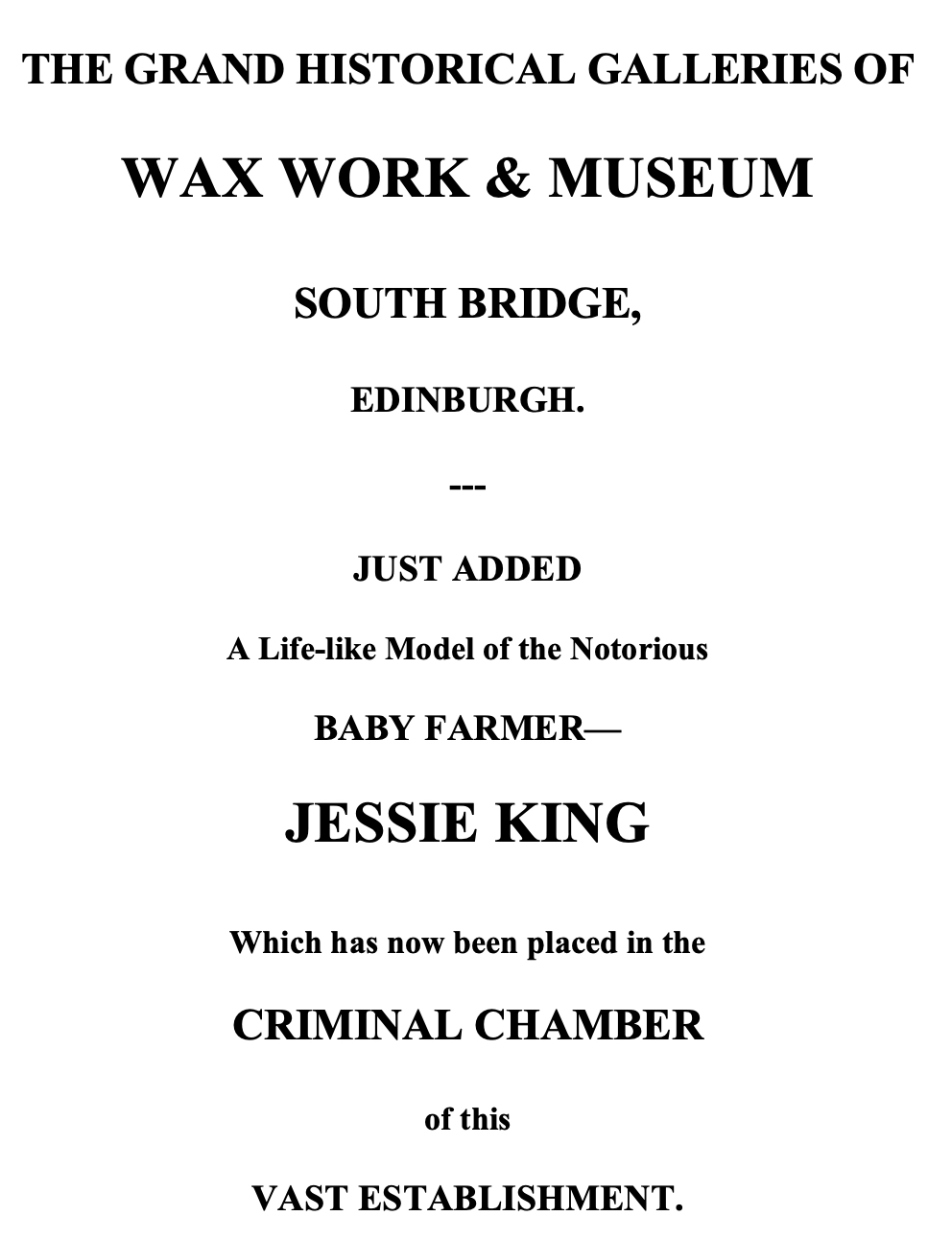
Portobello Advertiser, 11 July 1889
[6] For those using audio readers, the advertisement image above reads: 'The Grand Historical Galleries Wax Work & Museum, South Bridge, Edinburgh. Just added a life-like model of the notorious baby farmer—Jessie King which has now been placed in the Criminal Chamber of this vast establishment.' In this way, Jessie King is 'immortalised' in the public imagination as a harmless ghoul, an object of terror and disgust and popular harrowing entertainment.
[7] The establishment operated at 11 South Bridge under the proprietorship of Matthew Macleod from 1863 to 1914, when the exhibits were auctioned, the premises changed hands, and the wax work museum became a photography studio. (A new building on the site now houses Subway and Mail Boxes Etc.) The National Galleries of Scotland hold an Edinburgh Photographic Society image of it dating from June 1914, Accession Number PGP EPS 644.142.
[8] Notes on the Jessie King case have been much improved by the anthropological input of Dominie McIntosh and the genealogical expertise of Caroline Gerald. Thanks go to both.
